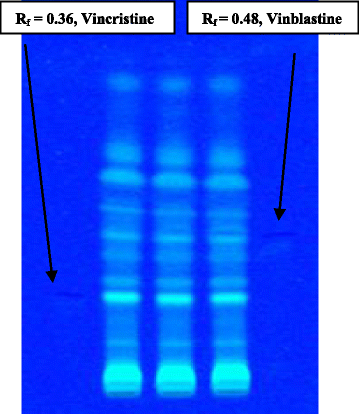Anti-diabetic potential of Catharanthus roseus Linn. and its effect on the glucose transport gene (GLUT-2 and GLUT-4) in streptozotocin induced diabetic wistar rats
- PMID: 26490765
- PMCID: PMC4618145
- DOI: 10.1186/s12906-015-0899-6
Anti-diabetic potential of Catharanthus roseus Linn. and its effect on the glucose transport gene (GLUT-2 and GLUT-4) in streptozotocin induced diabetic wistar rats
Abstract
Background: Catharanthus roseus is an important Ayurvedic medication in traditional medicine. It is potentially used in countries like India, South Africa, China and Malaysia for the healing of diabetes mellitus. Although, the molecular mechanisms behind this effect are yet to be exclusively explored. Due to the great antidiabetic and hyperlipidemic potential of c. roseus, we hypothesized that the insulin mimetic effect of ethanolic extract of c. roseus might add to glucose uptake through improvement in the expression of genes of the glucose transporter (GLUT) family messenger RNA (mRNA) in liver.
Methods: STZ-induced diabetic rats treated by ethanolic extract of c. roseus 100 mg/kg and 200 mg/kg; and one group treated with Metformin (100 mg/kg). After final administration of treatment of 4 weeks, blood samples were collected under fasting conditions, and the body weights (BWs) were measured. Total RNA from liver was extracted with the Qiagen RNEasy Micro kit (GERMANY) as described in the manufacturer's instructions. First-strand complementary DNA (cDNA) was synthesized at 40 °C by priming with oligo-dT12-18 (Invitrogen, USA) and using Super ScriptII reverse transcriptase according to the protocol provided by the manufacturer (Invitrogen, USA). Real-time polymerase chain reaction (PCR) amplifications for GLUT-4 (gene ID: 25139) were conducted using Light-Cycler 480 (Roche, USA) with the SyBr® I nucleic acid stain (Invitrogen, USA) according to the manufacturer's instructions. Polymerase chain reaction products of β-actin primer gene were used as an internal standard.
Results: The proposed study was framed to look at the antidiabetic efficacy of ethanolic extract of c. roseus and an expression of GLUT-2 and GLUT-4 gene in streptozotocin induced diabetic wistar rats. The doses were administered orally at a rate of 100 and 200 mg/kg and detrain the glucose transport system in liver for 4 weeks. The observed results showed a good positive correlation between intracellular calcium and insulin release levels in isolated islets of Langerhans. The supplementation of ethanolic extract of c. roseus significantly amplified the expression of GLUT gene mRNA by Real Time PCR in liver of diabetic rats.
Conclusions: We conclude that the observed antidiabetic effect of c. roseus on STZ induced diabetes was a result of complex mechanisms of GLUT gene mRNA expression. The findings are very encouraging and greatly advocate its candidature for the design of a novel herbal drug to cure deadly diabetes.
Figures



Similar articles
-
Aqueous extract of tamarind seeds selectively increases glucose transporter-2, glucose transporter-4, and islets' intracellular calcium levels and stimulates β-cell proliferation resulting in improved glucose homeostasis in rats with streptozotocin-induced diabetes mellitus.Nutr Res. 2012 Aug;32(8):626-36. doi: 10.1016/j.nutres.2012.06.015. Epub 2012 Aug 3. Nutr Res. 2012. PMID: 22935346
-
Natural product vindoline stimulates insulin secretion and efficiently ameliorates glucose homeostasis in diabetic murine models.J Ethnopharmacol. 2013 Oct 28;150(1):285-97. doi: 10.1016/j.jep.2013.08.043. Epub 2013 Sep 5. J Ethnopharmacol. 2013. PMID: 24012527
-
Extract of Woodfordia fruticosa flowers ameliorates hyperglycemia, oxidative stress and improves β-cell function in streptozotocin-nicotinamide induced diabetic rats.J Ethnopharmacol. 2015 Dec 4;175:229-40. doi: 10.1016/j.jep.2015.08.057. Epub 2015 Sep 2. J Ethnopharmacol. 2015. PMID: 26342523
-
Pharmacological potential of bioactive compounds in Catharanthus roseus extract: A comprehensive review.Toxicol Rep. 2025 Mar 17;14:101998. doi: 10.1016/j.toxrep.2025.101998. eCollection 2025 Jun. Toxicol Rep. 2025. PMID: 40213418 Free PMC article. Review.
-
An overview of the ameliorative efficacy of Catharanthus roseus extract against Cd2+ toxicity: implications for human health and remediation strategies.Front Public Health. 2024 Mar 8;12:1327611. doi: 10.3389/fpubh.2024.1327611. eCollection 2024. Front Public Health. 2024. PMID: 38525339 Free PMC article. Review.
Cited by
-
Exploring the Therapeutic Potential of Natural Plants in Modulating Molecular and Cellular Pathways Involved in Diabetic Neuropathy: Mechanism and Biochemical Evaluation.Curr Pharm Des. 2025;31(14):1087-1099. doi: 10.2174/0113816128335400241101115928. Curr Pharm Des. 2025. PMID: 39754768 Review.
-
In Vitro Evaluation of Antidiabetic Potential of Cleistocalyx nervosum var. paniala Fruit Extract.Plants (Basel). 2022 Dec 26;12(1):112. doi: 10.3390/plants12010112. Plants (Basel). 2022. PMID: 36616242 Free PMC article.
-
Ficus deltoidea extract down-regulates protein tyrosine phosphatase 1B expression in a rat model of type 2 diabetes mellitus: a new insight into its antidiabetic mechanism.J Nutr Sci. 2020 Jan 20;9:e2. doi: 10.1017/jns.2019.40. J Nutr Sci. 2020. PMID: 32042410 Free PMC article.
-
The Potential Therapeutic Value of Medicinal Plants in the Management of Metabolic Disorders.Molecules. 2020 Jun 9;25(11):2669. doi: 10.3390/molecules25112669. Molecules. 2020. PMID: 32526850 Free PMC article. Review.
-
Role of medicinal plants in the management of diabetes mellitus: a review.3 Biotech. 2019 Jan;9(1):4. doi: 10.1007/s13205-018-1528-0. Epub 2018 Dec 12. 3 Biotech. 2019. PMID: 30555770 Free PMC article. Review.
References
-
- World Health Organization. Diabetes Programme. 2012. http//www.who.Int/diabetes/en/. Accessed 28 Dec 2014.
-
- World Health Organization. WHO Study group of prevention of Diabetes Mellitus. WHO Technical 5 Report Series No. 844; 1994. p. 1–100. http://apps.who.int/iris/bitstream/10665/39374/1/WHO_TRS_844.pdf, Accessed 28 Dec 2014. - PubMed
Publication types
MeSH terms
Substances
LinkOut - more resources
Full Text Sources
Other Literature Sources
Medical

